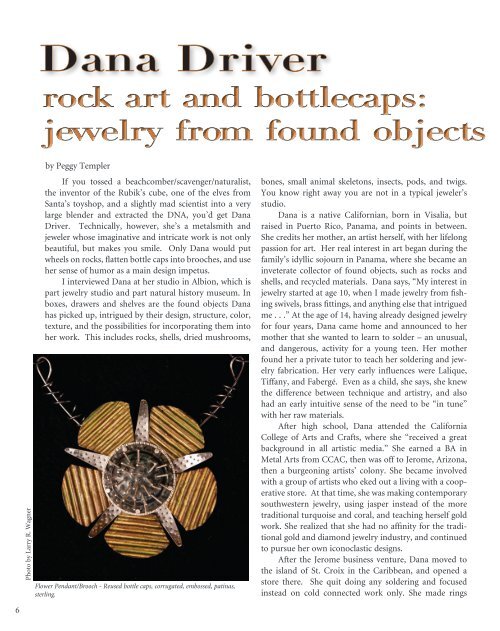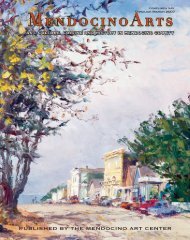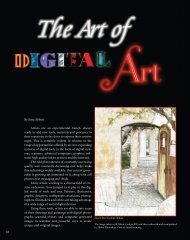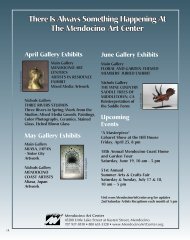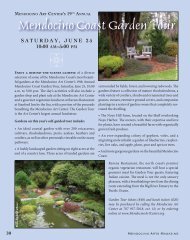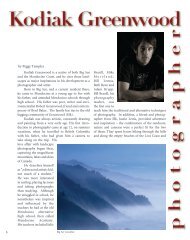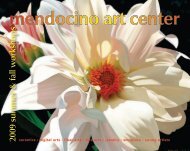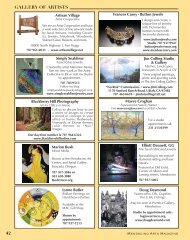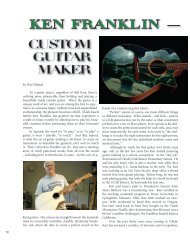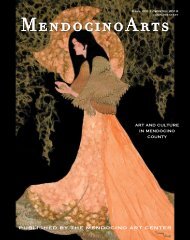Create successful ePaper yourself
Turn your PDF publications into a flip-book with our unique Google optimized e-Paper software.
6<br />
Photo by Larry R. Wagner<br />
<strong>Dana</strong> <strong>Driver</strong><br />
rock art and bottlecaps:<br />
jewelry from found objects<br />
by Peggy Templer<br />
If you tossed a beachcomber/scavenger/naturalist,<br />
the inventor of the Rubik’s cube, one of the elves from<br />
Santa’s toyshop, and a slightly mad scientist into a very<br />
large blender and extracted the DNA, you’d get <strong>Dana</strong><br />
<strong>Driver</strong>. Technically, however, she’s a metalsmith and<br />
jeweler whose imaginative and intricate work is not only<br />
beautiful, but makes you smile. Only <strong>Dana</strong> would put<br />
wheels on rocks, flatten bottle caps into brooches, and use<br />
her sense of humor as a main design impetus.<br />
I interviewed <strong>Dana</strong> at her studio in Albion, which is<br />
part jewelry studio and part natural history museum. In<br />
boxes, drawers and shelves are the found objects <strong>Dana</strong><br />
has picked up, intrigued by their design, structure, color,<br />
texture, and the possibilities for incorporating them into<br />
her work. This includes rocks, shells, dried mushrooms,<br />
Flower Pendant/Brooch - Reused bottle caps, corrugated, embossed, patinas,<br />
sterling.<br />
bones, small animal skeletons, insects, pods, and twigs.<br />
You know right away you are not in a typical jeweler’s<br />
studio.<br />
<strong>Dana</strong> is a native Californian, born in Visalia, but<br />
raised in Puerto Rico, Panama, and points in between.<br />
She credits her mother, an artist herself, with her lifelong<br />
passion for art. Her real interest in art began during the<br />
family’s idyllic sojourn in Panama, where she became an<br />
inveterate collector of found objects, such as rocks and<br />
shells, and recycled materials. <strong>Dana</strong> says, “My interest in<br />
jewelry started at age 10, when I made jewelry from fishing<br />
swivels, brass fittings, and anything else that intrigued<br />
me . . .” At the age of 14, having already designed jewelry<br />
for four years, <strong>Dana</strong> came home and announced to her<br />
mother that she wanted to learn to solder – an unusual,<br />
and dangerous, activity for a young teen. Her mother<br />
found her a private tutor to teach her soldering and jewelry<br />
fabrication. Her very early influences were Lalique,<br />
Tiffany, and Fabergé. Even as a child, she says, she knew<br />
the difference between technique and artistry, and also<br />
had an early intuitive sense of the need to be “in tune”<br />
with her raw materials.<br />
After high school, <strong>Dana</strong> attended the California<br />
College of <strong>Art</strong>s and Crafts, where she “received a great<br />
background in all artistic media.” She earned a BA in<br />
Metal <strong>Art</strong>s from CCAC, then was off to Jerome, Arizona,<br />
then a burgeoning artists’ colony. She became involved<br />
with a group of artists who eked out a living with a cooperative<br />
store. At that time, she was making contemporary<br />
southwestern jewelry, using jasper instead of the more<br />
traditional turquoise and coral, and teaching herself gold<br />
work. She realized that she had no affinity for the traditional<br />
gold and diamond jewelry industry, and continued<br />
to pursue her own iconoclastic designs.<br />
After the Jerome business venture, <strong>Dana</strong> moved to<br />
the island of St. Croix in the Caribbean, and opened a<br />
store there. She quit doing any soldering and focused<br />
instead on cold connected work only. She made rings
and bracelets of stone and metal,<br />
“not that distinctive from other jewelers,<br />
but very contemporary with<br />
an unusual ‘ancient’ look to them.”<br />
While living on St. Croix, <strong>Dana</strong><br />
became particularly fascinated with<br />
beach stones, basalt, shells and other<br />
‘detritus,’ and began “trying this and<br />
that and my style began to evolve. I<br />
also became very distressed thinking<br />
about the environmental cost of<br />
mining precious stones and metals,<br />
and began using found objects and<br />
beachstones in my work.” She walked<br />
the beaches, searching for and picking<br />
up “anomalies” – shells and rocks and<br />
tiny fish and bird bones – and then<br />
realized the work she wanted to do.<br />
According to <strong>Dana</strong>, this realization<br />
came as an urgent epiphany; she felt<br />
there was no time to lose to begin<br />
doing this work, which was to make<br />
art from natural materials, acquired<br />
by foraging, and to move completely<br />
away from traditional materials. She<br />
also at that time felt a need to be a<br />
part of a larger community of artists,<br />
and moved to the <strong>Mendocino</strong><br />
Coast, where her parents, Dan and<br />
Katherine <strong>Driver</strong>, had retired to the<br />
town of Albion. <strong>Dana</strong> then began<br />
the stunning work for which she is<br />
best known, in which she finds, polishes,<br />
carves and drills beach stones<br />
from the Albion shore, and inlays<br />
those with soft metals (gold and<br />
silver) hammered into the carved<br />
designs and fashioned into rings,<br />
brooches, pendants, and small sculptural<br />
pieces. She also began teaching<br />
an extremely popular class, “Primal<br />
Tech Rock <strong>Art</strong>,” at the <strong>Mendocino</strong><br />
<strong>Art</strong> <strong>Center</strong>.<br />
The process of figuring out how<br />
to carve and inlay stone took many<br />
months to “puzzle out,” which is one<br />
<strong>Art</strong>iculated Beetle – brooch-beach stone carved and<br />
inlaid with fine silver, sterling.<br />
Die Pendant – Bottle caps, copper, sterling, 14 kt.,<br />
patinas, fabricated, hinged together and opens to<br />
reveal the message “The Die Has Not Been Cast”<br />
Flamingo Brooch – beach stone carved and inlaid<br />
with fine silver, sterling, 18 kt., Iolite<br />
reason it was so intriguing to <strong>Dana</strong>.<br />
She is always most inspired when<br />
confronted with a challenge – how<br />
can she make this work? How can<br />
she solve the problems inherent in<br />
the designs she is creating? This process<br />
of working to resolve a puzzle<br />
is what keeps <strong>Dana</strong> energized and<br />
keeps her always trying to do something<br />
she has not done before.<br />
Which is how she arrived at<br />
her next challenge, bottlecap jewelry.<br />
<strong>Dana</strong> wanted to “recycle some<br />
material that’s abundantly around,”<br />
and from her long habits of foraging<br />
and staring at the ground,<br />
she realized that “creating jewelry<br />
from found bottle caps, tin cans, and<br />
rusty bits of metal would lessen my<br />
carbon footprint.” Her bottlecap<br />
jewelry is utterly unique – beautiful<br />
and fun.<br />
<strong>Dana</strong> foresees that her next<br />
passion will be automata, which<br />
refers to mechanical toys or “small<br />
sculptures that do stuff.” She loves<br />
the puzzle aspects of simple, basic<br />
mechanical movement, and has<br />
already experimented with her rock<br />
beetles with articulated legs and<br />
wheels.<br />
<strong>Dana</strong> credits Alexander<br />
Calder, whose work she first became<br />
acquainted with while attending<br />
CCAC, with being her “hero” and a<br />
major influence on her own work.<br />
The reason for that is that “everything<br />
he did, it looked like he had a<br />
pretty darned good time doing it.”<br />
And that is every bit as important to<br />
<strong>Dana</strong> <strong>Driver</strong> as it was to Alexander<br />
Calder.<br />
<strong>Dana</strong>’s work can be seen at<br />
North Coast <strong>Art</strong>ists, <strong>Mendocino</strong><br />
Jewelry Studio, and on her Web site at<br />
www.danarocks.com<br />
7
8<br />
S H A S H A H I G B Y<br />
International Performance/Sculptural <strong>Art</strong>ist to Perform<br />
at the Matheson Performing <strong>Art</strong>s <strong>Center</strong><br />
International performance/sculptural<br />
artist Sha Sha Higby is known for her<br />
evocative and haunting performances using<br />
the exquisite and ephemeral body sculpture<br />
she meticulously creates herself and moves<br />
within. Elaborate sculptural costume, dance,<br />
and puppetry explore magic and emotion,<br />
creating an atmospheric world within the<br />
borders between death and life. Ms. Higby<br />
has performed her unique body of work<br />
throughout the United States, and internationally<br />
in Korea, Japan, Indonesia, Slovak,<br />
Bulgaria, Singapore, Australia, Switzerland,<br />
England, Belgium, Germany and Holland.<br />
She is the recipient of numerous grants and<br />
awards. She studied for one year in Japan<br />
in 1971, observing the art of Noh Mask<br />
and theater and then received a Fulbright-<br />
Hayes Scholarship to study dance and shadow<br />
puppet making and performance arts in<br />
Indonesia for five years at the Academy of<br />
Music, Central Java, Indonesia. In addition<br />
to traveling throughout Southeast Asia Photo by Albert Hollander from Folds of Tea<br />
to Thailand and Myanmar (Burma), she<br />
received an Indo-American Fellowship to study the textile arts of India, and a Travel Grants Fund from <strong>Art</strong>s<br />
International to study in Bhutan. She has also recently studied lacquer arts in Tokyo and Kyoto, Japan through<br />
the auspices of the Japan-United States Friendship Commission. *
y Peggy Templer<br />
Sha Sha Higby could easily be the poster child for<br />
the single-child family. An only child until the age of<br />
eleven, this amazingly imaginative artist can trace her<br />
creative development back to the hours she spent alone<br />
in her upstairs bedroom as a child. She was constantly<br />
drawing, making up stories, creating dolls and puppets,<br />
imagining and producing entire travelogues with<br />
forests and trails and other destinations, all within the<br />
confines of her room. Her mother always encouraged<br />
her to indulge her imagination, and had endless<br />
patience for a creatively messy room. Her stepfather<br />
taught her to sew and was handy with tools, so that she<br />
began making things for their home and friends, dolls<br />
with long skinny legs, 100 mice finger puppets, eggs<br />
with scenes inside, stories embellished with costume<br />
and fabric. She also wrote stories and bound the books.<br />
Her mother opened a retail clothing store, but Sha Sha<br />
still made all of her own clothes.<br />
Sha Sha majored in art at Skidmore College, from<br />
which, during her junior year, she participated in an<br />
exchange program to Japan and wound up staying<br />
for one year instead of three weeks. In Japan she was<br />
introduced to many of the elements that would become<br />
features of her own life’s work – Kabuki theater, Noh<br />
mask carving, dance and movement, tea ceremony, calligraphy,<br />
elaborate Shinto and Buddhist rituals and rich<br />
costuming. According to Sha Sha, “Japanese crafts and<br />
Noh Theater, with its elaborate costuming and poetic<br />
structure, were the major influence on my work.”<br />
After returning from Japan, “on her own” as an artist,<br />
Sha Sha began making installation pieces for galleries,<br />
primarily small objects that were a cross between sculpture<br />
and puppetry strung on threads which “involved a<br />
lot of sewing,” as well as the use of carved wood which<br />
she learned from Noh Mask Carving. It was during this<br />
time that she became particularly intrigued with Butoh<br />
Dance performances. “The dancers’ bodies were like<br />
Above: Photo by Albert Hollander from Folds of Gold by Sha Sha Higby. Japanese urushi lacquer, gold leaf, embroidery, silver filigree leaves<br />
9
10<br />
The Song (“Naki Goe”) 12’ by<br />
4.5’ by 4’, mixed media including<br />
Japanese urushi<br />
sculptures and I was<br />
inspired by them to finally<br />
pull all of these elements<br />
together – dancing, movement,<br />
sculpture, puppetry,<br />
costuming and non-linear or<br />
non-verbal story telling.” Her first performance, in which<br />
she essentially mounted her elaborate sculpture on her<br />
back, took place in a private home. Sha Sha recalls this<br />
first performance as “the most exciting thing I had ever<br />
done. Everything all came together.” From then on, she<br />
did a performance a year, but as the costumes/puppets<br />
became more elaborate, the interval between performances<br />
became longer. Now it takes her up to two years to<br />
prepare the puppets and props for a performance. Over<br />
time the performances have become richer, incorporating<br />
more and more different mediums, including Japanese<br />
urushi lacquer, lighting and sound.<br />
Many times after performances, Sha Sha was asked<br />
to do workshops to teach students how to create the<br />
masks and costumes she uses in her unusual visual and<br />
performing art form. She has been a teacher throughout<br />
a few decades of touring, and has taught several times at<br />
the <strong>Mendocino</strong> <strong>Art</strong> <strong>Center</strong>. On October 23rd, she will be<br />
teaching a workshop, “Golden Archetype on a Stick” at<br />
the <strong>Mendocino</strong> <strong>Art</strong> <strong>Center</strong>, in which students will learn to<br />
cast, mold and recast theatrical masks, and mount them<br />
on sticks and add wires and ornamentation to make a<br />
spirit catcher.<br />
Sha Sha describes her performances as “like a poem<br />
or a painting with movement,” in which the meaning of<br />
the story is experienced in subtle, non-linear ways. The<br />
performances are choreographed to specific points on her<br />
journey but also spontaneous, like<br />
a drawing, as she dances along her<br />
way. They follow a progression from<br />
beginning to end, but the journey is mysterious<br />
and unscripted.<br />
The audience is an important<br />
part of Sha Sha’s performances. The<br />
audience comes along on the artist’s<br />
journey as, child-like, she<br />
plays with the toys and objects<br />
she comes across, building to a “crescendo<br />
of meaning and discovery,” which is subjective for<br />
each member of the audience. She attempts throughout<br />
the performance to draw her audience in by approaching<br />
them and by providing them with noisemakers, some of<br />
which (bird calls, rattles, etc.) have been made to enhance<br />
the story line, as the audience deems appropriate. After<br />
the performance, the audience is invited on stage to view<br />
the costumes, masks and props.<br />
Sha Sha’s performances are evocative of a child on<br />
a magical journey, discovering things for the first time,<br />
moving from experience to experience, dancing and<br />
exploring through the mysteries of life, as every child can,<br />
just like the child Sha Sha did alone in her upstairs room,<br />
way back in the beginning.<br />
Sha Sha’s work has been featured on the cover of<br />
Ornament Magazine as well as Crafts <strong>Art</strong>s International<br />
Magazine and Surface Design Magazine.<br />
This acclaimed artist will be performing at the Matheson<br />
Performing <strong>Art</strong>s <strong>Center</strong> on Sunday, October 24th, at 7 pm.<br />
Tickets are available in advance for $16 ($22 at the door).<br />
Phone the <strong>Mendocino</strong> <strong>Art</strong> <strong>Center</strong> at 707-937-5818 to order<br />
tickets.<br />
Sha Sha will also be teaching a workshop entitled “Golden<br />
Archetype on a Stick” on Saturday, October 23rd, the day<br />
before her performance, where you can create masks to use<br />
to participate in the performance. Contact Sha Sha Higby at<br />
415 868-2409 for details regarding the workshop.<br />
For more information about Sha Sha Higby and to view a<br />
movie of one of her performances, visit her Web site at www.<br />
shashahigby.com<br />
*reprinted from www.shashahigby.com
Book Review<br />
Maguey Journey<br />
by Kathryn Rousso<br />
reviewed by Barbara Shapiro<br />
Basket maker and former <strong>Mendocino</strong> resident<br />
Kathryn Rousso has devoted much of the past ten<br />
years to research about the maguey plant found from<br />
the southern United States to northern South America.<br />
This life sustaining plant provides food and beverage,<br />
clothing, shelter and, most prominently, thread<br />
for a wide variety of utilitarian objects. Fulbright<br />
Award winner Rousso’s research culminates in Maguey<br />
Journey: Discovering Textiles in Guatemala. Predating<br />
cotton, maguey production’s long history is tied to a<br />
continued subsistence lifestyle. Textile enthusiasts will<br />
love this book as will ethno-botanists, anthropologists,<br />
and travelers to Latin America. Rousso shares her passion<br />
for the quieter Guatemalan maguey textiles often<br />
overlooked by comparison to colorful backstrap woven<br />
cotton trajes. Her approach is culturally sensitive with<br />
attention to detail born from years<br />
of experience as a textile artist.<br />
In Part One, “The Land of<br />
Maguey,” we meet the men and<br />
women who for centuries have<br />
worked this strong and versatile<br />
fiber with varying techniques in<br />
Guatemala’s distinct geographic<br />
regions. We revel in a travelogue<br />
of Rousso’s sometimes harrowing<br />
research trips across Guatemala<br />
since the 1980’s. We meet the generous<br />
maguey workers she encountered<br />
whose practices vary by community.<br />
Part Two, “The Plant to<br />
Textile Transformation,” clarifies<br />
the biology, growth, fiber extraction,<br />
dyeing, spinning and textile<br />
production of maguey in a seemingly<br />
endless variety of structures.<br />
Techniques examined include<br />
looping, knitting, ply split darning,<br />
linking, interlacing, braiding, and weaving. There are<br />
diagrams and references for further study as well as<br />
beautiful photos. Rousso explains common equipment<br />
including several loom types and the many products<br />
fashioned from maguey including ropes, cargo nets,<br />
bags, tumplines, horse and mule gear, hammocks, and<br />
even fireworks. Part Three, “The Gift of Life,” explores<br />
the economics of this most persistent Guatemalan cottage<br />
industry. In spite of dramatic changes in demographics<br />
since post civil war stability encouraged greater<br />
international trade and the incursion of plastic into<br />
traditional life, Rousso is enthusiastic about a future for<br />
maguey as a sustainable green product. Maguey Journey<br />
is a fascinating read about the staying power of this<br />
durable fiber and the people who have mastered it.<br />
Maguey Journey: Discovering Textiles in Guatemala,<br />
University of Arizona Press,<br />
2010, is available at Amazon.<br />
com and through the publisher.<br />
Kathy Rousso is the former<br />
coordinator of the Fiber <strong>Art</strong>s<br />
Department at the <strong>Mendocino</strong><br />
<strong>Art</strong> <strong>Center</strong>. She currently<br />
resides in Ketchikan, Alaska.<br />
Barbara Shapiro is a textile artist<br />
and educator from the Bay<br />
Area. Her weavings and baskets<br />
are profoundly influenced<br />
by traditional and historic textile<br />
traditions. She is a board<br />
member of the Textile Society<br />
of America and recently taught<br />
an indigo dyeing workshop at<br />
the <strong>Mendocino</strong> <strong>Art</strong> <strong>Center</strong>.<br />
www.barbara-shapiro.com<br />
11
12<br />
Shozo Sato:<br />
Living Treasure<br />
by Michael Potts<br />
In a magical tea garden at the end of a tree tunnel<br />
in Inglenook, there lives a Japanese wizard. He is a private,<br />
gentle, courtly man, who nevertheless radiates a<br />
powerful force. He uses that force to transform people<br />
into artists.<br />
Shozo Sato describes Kamakura, where he grew<br />
up, as “a city of 100,000 people and 300 Zen temples:<br />
Kabuki actors, Nobel prize winners... a highly motivated<br />
culture.” Shozo’s father was a doctor, his mother<br />
an ardent theater-goer. Shozo was born in 1933, the<br />
year Japan left the League of Nations and began beating<br />
war drums. “When I was four, my father returned<br />
from a house call to find me dancing in a kimono of<br />
my mother’s. I started my study of traditional Japanese<br />
dance when I was six. Like other boys, I was always<br />
being asked what I wanted to become. Boys my age<br />
were expected to answer ‘pilot’ or ‘commander’ or<br />
‘soldier’ but I always said, ‘artist’. I was a problem kid,<br />
sneaking out of academic classes into other people’s<br />
art classes.<br />
“It was a blessing: from childhood, I always knew<br />
what I wanted to do.” Japanese who lived through the<br />
Occupation remember it as a harsh time, but Shozo<br />
stayed in his own room, practicing dance, painting,<br />
making drama. He attended a fine arts high school<br />
and college, taking a degree in oil painting. “My classmates<br />
always talked of going to Paris and New York to<br />
become famous artists, but they didn’t know Japanese<br />
art. I think, if you want to stand on the world stage,<br />
you must know your own native art, and the philosophy<br />
behind it, because eventually that will come out.<br />
“When I was 19, I began to wonder how to earn a<br />
living. My childhood mentor, a painting master, prohibited<br />
selling paintings, because this ‘success’ locks an<br />
artist into the style of the sold painting, and creativity<br />
is lost. This becomes a form of prostituting the soul. As<br />
an artist, you must not think of yourself as a merchant.<br />
So I offered my services to an orphanage for free. Every<br />
Saturday I taught art to orphans. In those days, the<br />
orphanages were filled with children of mixed races:<br />
Black, Brown, White, who were left in little baskets at<br />
the orphanage door. Every child has a different way of<br />
drawing, and to me their different ethnic backgrounds<br />
were obvious. Soon I was teaching art in the U.S. Naval<br />
Independent School. My talent for seeing ethnicity in<br />
paintings helped me understand that we all have different<br />
gifts. By encouraging these differences, we can<br />
help children find their creativity.”<br />
A resurgence in Japanese reverence for culture<br />
in the post-war years offered abundant opportunities<br />
for Shozo to learn new artistic disciplines. He studied<br />
Kabuki with one of the Living National Treasures,<br />
Nakamura, Kanzaburo XVII, who honored Shozo<br />
with the title Nakamura, Kanzo IV. During this time<br />
he also studied Ikebana (the art of arranging flowers)<br />
and the Tea Ceremony. He opened a small private art<br />
Photos by Larry R. Wagner
academy where he taught Sumi-E (black ink painting),<br />
Ikebana, the Tea Ceremony, and Kabuki Dance.<br />
Shozo recounts, “One day, a tall American lady, a<br />
Fulbright scholar from the University of Illinois, came<br />
to visit my academy. She wanted to learn why so many<br />
Japanese artists practice many disciplines. I told her,<br />
Simple: Japanese arts are all inter-related. Because<br />
Japan has few raw materials, the only way to survive<br />
on the international scene is to produce people with<br />
talent. After two weeks of attending classes, she asked<br />
me if I would come to Illinois if I was invited.”<br />
Shozo took the invitation to be a calling. From the<br />
mid-1960s, Professor Sato taught at the University of<br />
Illinois, Champaign-<br />
Urbana. He was<br />
often invited to<br />
other cities, universities,<br />
and museums<br />
to give lecturedemonstrations,<br />
becoming a roving<br />
ambassador for the<br />
Japanese arts. At<br />
the University of<br />
Illinois, his Kabuki<br />
Theater productions<br />
were enthusiastically<br />
received, transforming<br />
the way many<br />
midwesterners perceived their world. Appreciated for<br />
his unusual style and teaching gift, Shozo was granted<br />
permanent residency by an Act of Congress (90-S-2422<br />
sponsored by Senator Gaylord Nelson of Wisconsin).<br />
“Starting a Kabuki group in Japan is easy: you just<br />
go to the costumer and the wigmaker. In the midst of<br />
a cornfield in Illinois, you get books, learn how to sew<br />
costumes, find suitable materials, make wigs. Striving<br />
for authenticity, I learned a lot. I accepted my calling<br />
– maybe, more a matter of Karma? – to come to the<br />
United States and, being different, make use of those<br />
differences with my students, to try to open their<br />
eyes and hearts a little bit. In Japan and the U.S., this<br />
was a time of grassroots<br />
peace activity,<br />
and activists welcomed<br />
intercultural<br />
exchanges. We cannot<br />
leave peace up<br />
to governments,<br />
because industry<br />
pressures governments<br />
into wars ‘to<br />
make a buck.’”<br />
In 1967,<br />
Shozo was invited<br />
to <strong>Mendocino</strong> by<br />
Bill Zacha, whose<br />
interest in Japanese<br />
13
14<br />
art has enriched the <strong>Art</strong> <strong>Center</strong>. “I thought, ‘ocean,<br />
culture, just like Kamakura.’ I didn’t know it was a cold<br />
water place, and so on my first Sunday I put on my<br />
swimsuit and went to the beach. People were saying,<br />
‘look at that crazy guy.’ Ah! The <strong>Art</strong> <strong>Center</strong>, the ocean<br />
through the Cypress trees behind it: like Kamakura!”<br />
As his eminence grew, Professor’s Sato’s skill as a<br />
teacher increasingly called him away from Japan House,<br />
his Illinois venue, and all the travel on icy midwestern<br />
roads led him to look for a milder climate. <strong>Mendocino</strong><br />
called, and by 1990 he and his wife, Alice, chose to build<br />
his <strong>Center</strong> for the Japanese <strong>Art</strong>s in Northern California,<br />
north of Fort Bragg.<br />
“There is an art to knowing a student’s needs,<br />
presenting new ideas in a way that can be understood.<br />
University students take courses because school requires<br />
them to study different cultures. Older students, coming<br />
of their own will, are seeking something: Fun? Meaning?<br />
Philosophical background? Every one: different. My lefthanded<br />
Zen monk copies Sutras, learning every stroke<br />
backwards. It is impossible. In Japan, everyone learns to<br />
write with their right hands because Japanese is a righthanded<br />
system. I challenge each student with something<br />
exotic, entertaining, so, before they know, they are seriously<br />
studying. First, catch their interest, then gradually,<br />
like training a wild horse, sprinkle sugar cubes, carrots,<br />
whatever the horse likes...”<br />
Zacha’s interest in Japan kept the <strong>Art</strong> <strong>Center</strong> gazing<br />
westward, resulting in <strong>Mendocino</strong>’s sister city relationship<br />
with the town of Miasa. “I am pleased that the<br />
Miasa program carries on,” Shozo says. “The <strong>Art</strong> <strong>Center</strong><br />
can present events that open hearts to Asian sensibilities.<br />
Once our hearts open, we will maintain our quest for<br />
mastery of the art of life. It is an honor for me to have an<br />
opportunity to present this Japanese attitude to people<br />
who honestly wish to learn.<br />
“You see,” he continues, “Japan honors culture. For<br />
example, during a political campaign, people bring a nice<br />
piece of paper to a candidate and ask him to do some<br />
calligraphy. If they like what he paints, they vote for him.<br />
Calligraphy is a very revealing art and can show the quality<br />
of a person. In other disciplines, materials change,<br />
subjects differ, but the center of the self stays the same.”<br />
To share his art more widely, Shozo has produced<br />
four gorgeous books, two authoritative works for adults,<br />
Sumi-E: The <strong>Art</strong> Of Japanese Ink Painting and Ikebana:<br />
The <strong>Art</strong> Of Arranging Flowers, and two for children,<br />
Tea Ceremony and Ikebana: Asian <strong>Art</strong>s And Crafts For<br />
Creative Kids, all published by Tuttle.<br />
As befits a wizard, Professor Sato circulates, ageless,<br />
graceful, and wise, among his students in the workroom<br />
of his Inglenook academy, guiding a hesitant hand, whispering<br />
encouragement. A local physician looks up from<br />
a finished character. “This is harder than heart surgery,”<br />
he confesses. The wizard smiles.
<strong>Mendocino</strong><br />
Sandpiper<br />
Affordable Jewelry<br />
since 1987<br />
Featuring Jewelry<br />
by Tabra<br />
“Where The Locals Shop”<br />
937-3102<br />
45280 Main Street,<br />
<strong>Mendocino</strong><br />
Open Daily<br />
At west end of Main St.<br />
Roxanne Vold, Proprietor<br />
OCEANFRONT INN<br />
& COTTAGES<br />
Just steps to the beach and<br />
a stroll to fine restaurants, galleries<br />
and the <strong>Mendocino</strong> <strong>Art</strong> <strong>Center</strong>.<br />
ocean views • decks • fireplaces<br />
An enchanting refuge for<br />
rest and renewal...<br />
On Main Street at Evergreen<br />
<strong>Mendocino</strong> Village<br />
800 780-7905 • 707 937-5150<br />
www.oceanfrontmagic.com<br />
Studio<br />
& Gallery<br />
M E N D O C I N O<br />
gems<br />
Custom design & repair<br />
10483 Lansing St. • <strong>Mendocino</strong><br />
937-0299<br />
Kaleidoscopes ◆ <strong>Art</strong> Glass ◆ Mirrors ◆ Jewelry<br />
4 5 0 5 0 M a in S t r e e t ■ M e n d o c in o , C a l if o r ni a<br />
E n t r a n c e o n A l b i o n S t r e e t ■ O p e n d a i l y<br />
www.reflections-k aleidoscopes.com ■ 937- 0173<br />
15


